After having spent the past eight years crossing oceans on our 40 year old Valiant 40, we have discovered what equipment has given us the best service and lasted the longest (published October 2015)
STEERING PEDESTAL
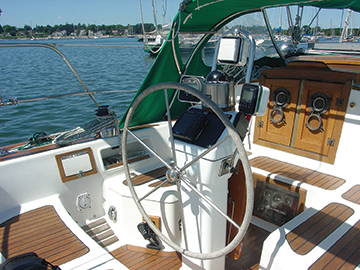
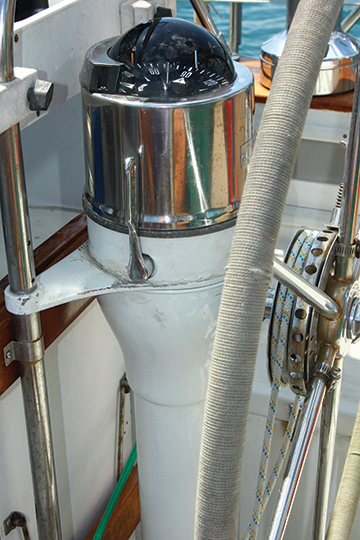
It speaks well that Yacht Specialties pedestals are still steering yachts over 40 years after their installation. But when the gear shift lever mounting, in our 1976 Yacht Specialties pedestal, broke, it was a major problem. Yacht Specialties went out of business long ago so a replacement part was difficult to find. Using Marine-Tex as a glue and thin stainless plates as splints and tiny bolts to join it all, I was able to make a solid repair. As luck would have it, emailing Newport Nautical in Newport, Rhode Island (www.newportnautical.com) resulted in them dusting off an old Yacht Specialties pedestal and they shipped a replacement part to me in Indonesia. That part is now stored as a backup. When we are in a more yacht repair friendly location, where there are proper facilities and access to real boat supplies, I do look forward to the possibility of installing a new Edson pedestal (www.edsonmarine.com).
BILGE PUMP
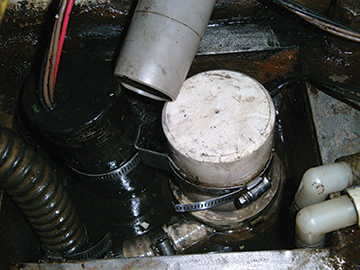
The Rule 1500 submersible bilge pump is at least 13 years old. From the main bilge sump, it kicks out shower water, which drains from the head, and any salt water that enters from the engine room. Once a month, I take the bottom strainer apart to clean any muck from the pump. At the same time I disassemble the float switch and clean residue from the inside of the column and the float to keep it from sticking. Even though I occasionally pour laundry detergent and bleach into the sump, the strong cleaners have had no negative effects.
ENGINE ROOM BLOWER
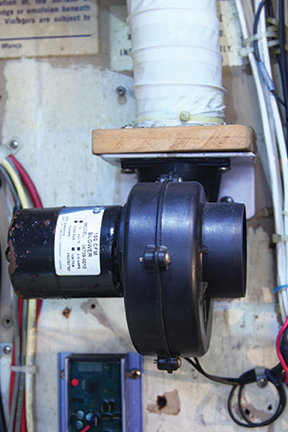
The Jabsco 150CFM blower is on anytime the engine is running, for an hour or days at a time. It helps to clear warm air from the engine room and bring in fresh cool air for the diesel engine. After 3,000 hours of running time, the blower is still sucking and blowing as hard as ever.
HEADACHE
After eight years of use, when pumping the head, it would at times inexplicably plug. Disassembling the first exit hose, I found that calcium build up had accumulated like growth rings in a tree. The restriction reduced the diameter by about 50 percent. After removing the hose from the boat, a hammer was used to break up and beat out the soft calcium. The most difficult part of this operation was disassembly; twisting and prying the stiffened hoses off of the plumbing barbs. Upon reinstallation, the only way to eliminate leaks, due to the lack of elasticity of the hose, was to coat the joint with Life Caulk. The caulk on the plastic fittings and inside the hose is adequate to make a seal without being tenacious and causing future removal headaches.
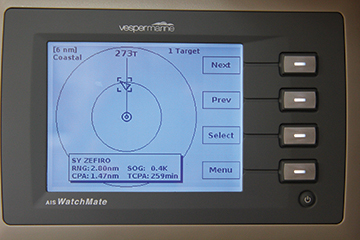
VESPERMARINE AIS 750
We upgraded our original six year old Vesper Marine 650 AIS display to the WatchMate 750 and Vesper’s excellent customer service sent it economically to us in Indonesia. The newer machine is still being used as a dedicated display for our AIS transponder but has the added benefit of a built-in AIS receiver, in case our old transponder/receiver ever breaks. The 750 also has an anchor alarm. It is all a nice upgrade. The switchover was simple using the original wiring (although the wire colors have changed a bit), and the same mounting bracket. These days, it would be unwise to ocean sail without a quality AIS transceiver and stand alone display.
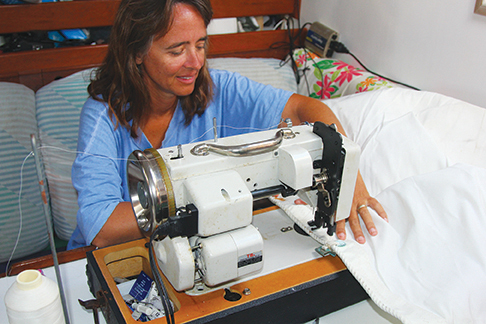
RELIABLE BARRACUDA SEWING MACHINE
Only a few years after setting out on our cruise we decided our 40 foot boat was not big enough. Every compartment and cabinet is now full of everything from tools and backup equipment to food and other consumable supplies. To save space, we do not have the bulk of extra sails in large bags. Instead, we have high quality sails on roller furlers and as a back up, we have stowed a Reliable Barracuda 2000U-3G sewing machine. Not only can it be used for sewing a straight or zigzag stitch through many layers of a jib, we use it for repairing the bimini, dinghy chaps and cushion covers. Four years ago we ordered our sewing machine through the Defender catalog. Comparing the Barracuda to another popular brand, it appeared to me these were the same machines, as long as you added the optional Cuda Crank Handwheel, but the Barracuda costs less. Reliable Barracuda’s excellent customer service department put together a “cruisers kit” that includes any and all parts that could possibly need replacing when we are in the middle of nowhere.
GALLEY STOVE
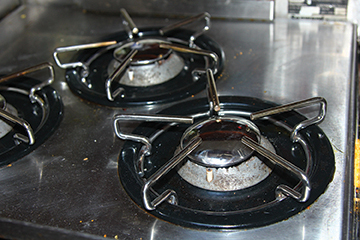
In less than three years, the pot supports and domed burner caps of our Seaward, Princess Gourmet II galley stove were reduced to skinny remnants of rust. Fortunately, in Indonesia, a machine shop was able to make new stainless steel pot supports for $13 each. The new burner caps were made on a lathe from solid blocks of stainless and cost us $10 each. But for the burner caps, there are important cutouts and shapings on the bottom edge which make for a beautiful blue flame or a soot producing yellow flame. It is not easy to get the engineering perfect.
CHAIN HOOK
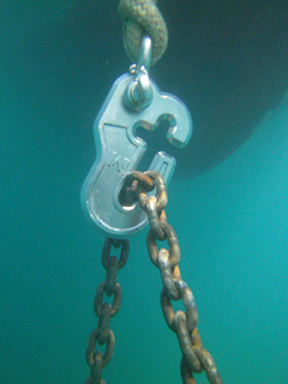
I don’t know exactly why it happens but it does. When the wind is against the current and the sailboat dances around, our traditional snubber hook would at times fall off the chain, no matter how much chain is looped from the deck. The load is then placed directly on the windlass. The windlass is for raising and lowering the anchor, not for securing it to the boat. So we ordered a Mantus chain hook (www.mantusanchors.com) which looked like a bright idea, and it is. It is easy to set on the anchor chain and seems impossible to fall off on its own. As further security, there is a plastic gate that fits over the chain slot if someone thinks they need a snubber long enough to drag the Mantus hook around the bottom of the anchorage. There is a large shackle on the Mantus which makes it easy to attach an oversized snubber line or a second line to go to a second deck cleat to spread the load. We chose the stainless over the galvanized version.
MONITOR, MRUD EMERGENCY RUDDER
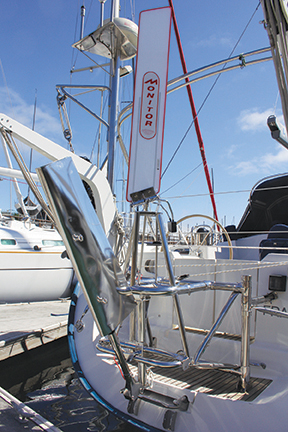
In Indonesia, because of rocks and dead coral heads, it was more often a problem getting the anchor up than making it stay put. But one day when a sudden onshore squall pushed our boat and caused the anchor to drag, the skeg and rudder got in a boxing match with a large rock. Temporary repairs were effective but to make permanent repairs, we had to sail hundreds of miles to a haul out facility. As a precaution, we wanted to have on board backup steering equipment which attaches to our Monitor self steering vane called an MRUD (www.selfsteer.com). We were able to borrow one from another cruising yacht. The MRUD is a proven emergency steering system which has steered disabled yachts thousands of miles. Appearance-wise, it looks like a Monitor water paddle but is approximately 50 percent larger than the standard pendulum. In addition, it is fixed to the Monitor frame so it cannot swing but can only rotate along its vertical axis, like a rudder. To help support the load of the higher stresses, additional stainless steel tubing supports are sometimes required to a standard Monitor self steering vane. Scanmar provides these with the Monitor self steering windvane for use with the MRUD as part of the mounting system. Fortunately we did not have to use the MRUD. But the MRUD is a piece of backup equipment we want to add to our inventory. The MRUD should be highly considered as necessary equipment especially for any boat with an unprotected spade rudder. Because the emergency MRUD is mounted so far aft of the boat, the leverage of steering is great but not as quick responding as a normal rudder.
SEA BREATHE 12 VOLT HOOKAH
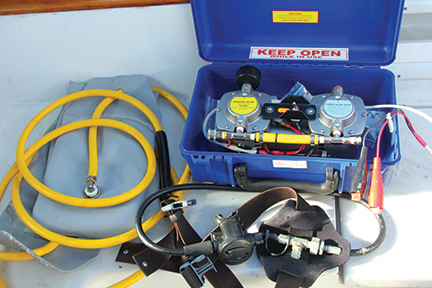
We have a scuba tank on board but it is rarely used for sport. That tank is in reserve for deep water emergencies like when our anchor or chain gets wrapped up in water beyond snorkeling range. For the past eight years, for shallow water work, we have always had on board a Sea Breathe hookah. It has been invaluable for spending long periods of time cleaning growth from the hull, changing zincs or other underwater repairs. Our Seabreathe will get a single diver down to 35 feet and will pump air for hours, as long as our batteries have a 12-volt charge.
Any sailboat is a constant maintenance project but installing quality equipment helps to keep the fun to work ratio in proper balance.
Americans Patrick and Rebecca Childress are now half way around the world in year eight of what was supposed to be a four year circumnavigation.

















